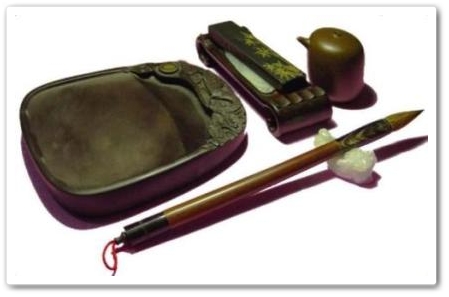Home >> Art >> Calligraphy >> Styles Four Treasures Masters Gallery Famous Chinese Calligraphy
Four Treasures of the Study (文房四宝 wén fáng sì bǎo) is an expression used to refer to the ink brush, inkstick, paper and inkstone used in Chinese calligraphy and painting. The name stems from the time of the Southern and Northern Dynasties (420-589 AD). Brushes and ink are two of the legendary “Four Treasures of the Study” tools of Chinese calligraphers, painters and poets over thousands of years. The other vital elements of culture are the rice paper (zhi), and the inkstone (yan) for grinding the solidified inksticks.

The traditional brush (bi) can be traced back to the neolithic age, but became recognized during the Warring States Period, in 476 to 221 BC. It was improved by Meng Tian, a general of the Qin Dynasty, in 221 to 206 BC. Brushes are made of animal hair, usually attached to a bamboo stick. Various kinds of animal hair were once used, like goat, ox, rabbit, sheep, marten, badger, deer, wolf, each having certain properties. They can be categorized by their size: large, medium and small; and also by the strength: soft (usually taken from goat), medium (taken from rabbit, or a mixture of goat and weasel hair) and hard or stiff (taken from weasel tail). Hair of different animals can be combined to create different textures.
The ink (mo) is commonly made by burning pine or another wood in an earthenware container, mixing dense ash with glue, and compressing it into an ink stick, or another form. An unusual antique piece of ink is shaped like a ruyi, a scepter tribute offering, that conveys wishes for happiness and good fortune. After shaping, it takes about two years for the ink to dry, in a totally dry and dark environment.
Paper is usually made from parts of the rice plant, like rice straw or rice flour. The paper in the old days is very thin and light. Thus it can adsorb ink easily.
An inkstone is literally a stone mortar for the grinding and containment of ink. Traditional Chinese ink is usually solidified into sticks for easier transport and preservation. Water is usually kept in a ceramic container and sprinkled on the inkstone, which has a generally flat surface. The inkstick would be ground with the flat surface of the inkstone. By mixing ink with different amounts of water, the calligrapher or artist can create different densities and innumerable shades of black and gray.
Gallery of the Four Treasures from the Palace Museum (Forbidden City) in Beijing